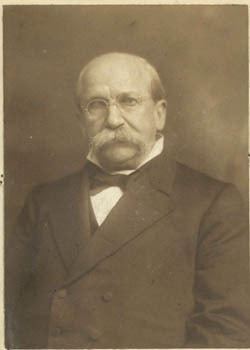Name William Larrabee Role American Politician | Died November 16, 1912 Books The railroad question | |
 | ||
William Larrabee (January 20, 1832 – November 16, 1912) was an American Republican politician from Iowa. He served as the 13th Governor of Iowa from 1886 until 1890.
Contents
Early life
Larrabee was born in Ledyard, Connecticut, into a family of French Huguenot extraction. His father, Adam Larrabee (1787–1869), was a West Point graduate and an accomplished soldier, who served with distinction in the War of 1812. His mother was Hannah (née Lester).
Larrabee was the seventh of nine children, and grew up on his father's Connecticut farm. He was educated in local schools until the age of 19. At around age 15 Larrabee lost the eyesight in his right eye after a gun he was holding accidentally discharged. As a result, he was unfit for many careers available to young men of his class in New England. Larrabee chose to become a teacher. In 1853, at age 21, he moved to Iowa following an older sister in search of opportunity.
In Iowa, Larrabee taught school for a few years, but soon after his arrival established himself as a successful miller, banker, and farmer in Clermont. He attempted to enlist at the outbreak of the Civil War, but was rejected on account of his disability. Larrabee prospered in business and eventually became of one of the biggest landowners in the state.
Political career
Larrabee entered politics in 1867, having bypassed local politics. He was elected to the Iowa Senate as a Republican, after helping organize the newly created party in Iowa. Larrabee was reelected many times, sometimes without even nominal Democratic opposition. While a legislator, Larrabee served on several committees, and eventually came to chair the influential Ways and Means committee.
He was elected as Governor in 1885 succeeding Buren R. Sherman, and served two two-year terms, from January 14, 1886 until February 27, 1890.
The byline of his first campaign was "a schoolhouse on every hill and no saloons in the valley." In the general election he faced Democrat Charles Whiting, who attempted to portray Larrabee as an unredeemed capitalist and owners of many locals' debts. The election was relatively close, but Larrabee won with 175,504 votes to Whiting's 168,502.
After serving two terms as governor, Larrabee retired to Montauk, his family mansion in Clermont. He served in several minor public roles after retiring. At the end of his life he supported Theodore Roosevelt and the Bull Moose faction of the Republican party.
Personal life
Larrabee married Anna Matilda Appleman on September 12, 1861. The Larrabees had seven children: Charles, Augusta, Julia, Anna, William Jr., Frederic and Helen. Julia married Don Lathrop Love, future Republican mayor of Lincoln, Nebraska.
Larrabee had a large library and was fond of reading. He also experimented with fruit growing and liked to travel, at one point spending several months in Europe and Palestine in 1873.
Larrabee was a Methodist.
Larrabee died on November 16, 1912, and was buried at God's Acre Cemetery in Clermont alongside his wife.
